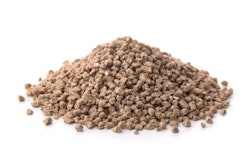
Despite a strong start and growth in poultry sector, Brazilian compound feed production is expected to fall flat due to currency volatility and high commodity costs in 2016.
“The demand for feed accounted for 33.3 million metric tons of compound feed production [in the first half of 2016] — a 3.2 percent growth rate compared to the same period last year,” says Ariovaldo Zani, CEO of Brazilian feed industry association, Sindirações. “Considering weak domestic demand and the continuous high cost of corn and soybean meal, the amount produced in the second half will offset this growth. Hence, overall feed production during 2016 will account for slightly more than 66 million metric tons.”
In 2015, the country produced 66.3 million metric tons of compound feed production, rounding out three years of consecutive growth.
Poultry growth, static feed production
Brazilian poultry production has grown by nearly 4 percent to 13.6 million metric tons in 2016, the USDA’s Foreign Agriculture Service GAIN Report notes. In 2017, the report forecasts broiler production to grow by 3 percent, topping 14 million metric tons.
However, Zani feels broiler production may drop off.
“So far, broiler producers have demanded 16.8 million metric tons of feed, an increase of 4.2 percent, in response to chicken housing, which grew approximately 4 percent during the first half, and vigorous chicken exports that were favored by the exchange rate and new global opportunities,” Zani explains.“Nevertheless, insufficient relief in the cost of production and the revaluation of the local currency (real) should discourage the housing intention, reduce the production of chicken and, consequently, the demand for feed in the second half.”
Broiler exports grew by more than 9 percent due to “avian influenza, competitive prices of the Brazilian poultry meat, the PIS/COFINS tax exemptions and high demand from China.
“The domestic consumer’s purchasing power has declined because the economic deterioration, mainly because poultry increasingly replaced beef,” Zani explains, noting its influence in weakening domestic consumption. “The devaluation of the local currency and the avian influenza outbreaks in exporting countries, as well, circumstantially favored poultry shipments abroad.”
Despite growth in the sector overall — and in contrast to the GAIN report’s record output predictions for 2017 — Zani predicts 2016 broiler feed production will flatline from July to December, with estimated compound volumes of 32 million metric tons. To offer perspective, broiler producers consumed 32.4 million metric tons of compound feed in 2015.
Recent drop in corn prices
Over the past 12 months, the average cost of broiler production increased by 34 percent due to corn and soybean meal prices. However, according to the Brazil’s Central Intelligence Poultry and Swine (CIAS) with the Brazilian Agricultural Research Corporation (Embrapa), production costs fell by 7.1 percent for broilers producers in July.
The Brazilian government released corn from public stocks and reduced the import tariff for non-Mercosul suppliers after drought hit the second crop, known as the safrinha, and caused corn prices to surge by more than 88 percent, the GAIN Report states, noting that independent producers have been more affected by corn shortages than integrators.
















